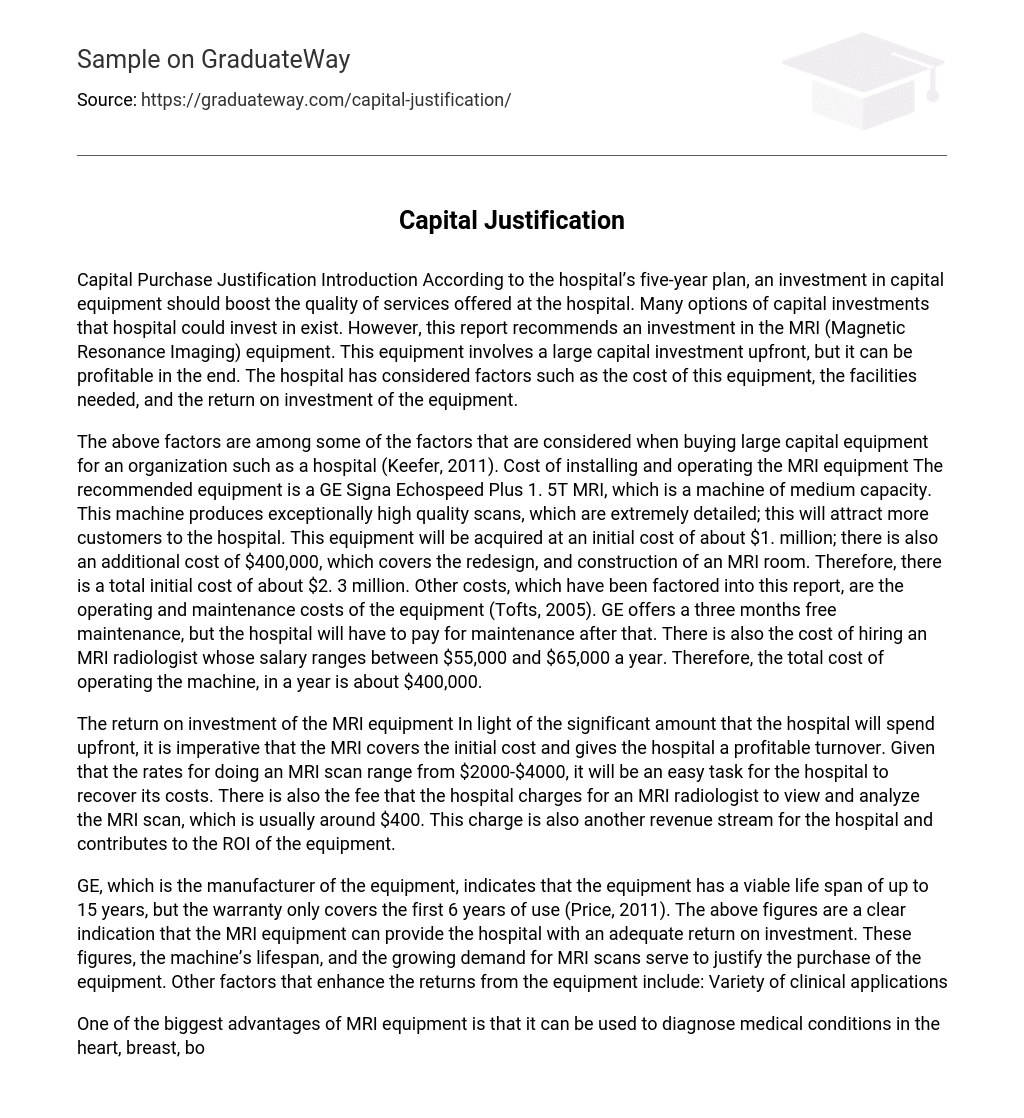According to the hospital’s five-year plan, investing in capital equipment will enhance service quality. While there are various choices for capital investments, this report recommends prioritizing investment in MRI (Magnetic Resonance Imaging) equipment. Despite its significant initial expense, this equipment has the potential to generate profits. The hospital has carefully considered the cost, required facilities, and return on investment associated with this equipment.
When considering the purchase of large capital equipment for a hospital, it is important to take into account both installation and operational costs. In this case, we recommend the GE Signa Echospeed Plus 1.5T MRI machine, which is classified as a medium-capacity device. This machine provides high-quality scans that are detailed and attractive to customers. The initial cost of acquiring this equipment is approximately $1.2 million, with an additional $400,000 needed for constructing an MRI room. Thus, the total initial cost amounts to around $2.3 million.
This report also considers the ongoing expenses associated with operating and maintaining the equipment. While GE offers three months of complimentary maintenance services, subsequent maintenance costs will be borne by the hospital. Additionally, there is a requirement to hire an MRI radiologist who would receive an annual salary ranging from $55,000 to $65,000 per year. As a result, the estimated annual operating cost for using this machine comes to about $400,000.
The MRI equipment’s return on investment is crucial for the hospital. With a significant upfront cost, it is crucial for the MRI to generate profit and pay for itself. Fortunately, the hospital can easily recover its costs since the rates for MRI scans range from $2000 to $4000. Additionally, the hospital charges a fee of around $400 for an MRI radiologist to analyze the scan. This fee is another source of revenue and contributes to the equipment’s ROI.
GE, the equipment manufacturer, states that the equipment has a lifespan of up to 15 years, but the warranty only covers the first 6 years of use (Price, 2011). These statistics demonstrate that the MRI equipment can bring a satisfactory return on investment to the hospital. The longevity of the machine, along with the increasing demand for MRI scans, supports the decision to purchase the equipment. Additionally, other factors that contribute to higher returns from the equipment include its versatility in clinical applications.
MRI equipment is highly advantageous as it has the ability to diagnose medical conditions in various parts of the body, including the heart, breast, bones, spine, and brain. This unique feature makes it an essential tool in healthcare. It effectively detects stroke, blockages in the circulatory system, cardiovascular conditions, tumors, and injuries. In addition to its versatility and wide range of uses, MRI equipment also provides higher quality imaging when compared to other imaging equipment (Keefer, 2011).
Utilizing advanced technology, the MRI equipment is capable of generating high-resolution 3D images that provide exceptional clarity. This plays a vital role in identifying and diagnosing conditions such as blood vessel obstructions and tumors. Consequently, the hospital anticipates an increase in referrals for imaging services and profitability from utilizing the MRI machine (Price, 2011). Additionally, with the rising number of cancer cases, there is a growing demand for imaging services. Therefore, acquiring this machine is a logical decision given the escalating need for imaging services.
The MRI machine has improved scanning speed with its new technology. It is capable of providing immediate results during and after the scan, unlike other technologies like x-rays that require processing time. The machine features a real-time locator for quick data reconstruction and display of results. The faster scanning speeds also allow for maximum utilization of the machine, serving more patients (Tofts, 2005).
The initial investment for purchasing and installing the MRI machine is around $2.3 million, which is a substantial cost. Additionally, there are ongoing operational expenses linked to the machine. However, despite these considerable costs, the report emphasizes various factors that justify obtaining this equipment. The hospital can recuperate its investment in the equipment through the high charges for MRI imaging.
The profitability of investing in this machine is also influenced by increased scan speed, improved imaging quality, and a variety of clinical applications. In addition, the demand for imaging services is on the rise. References:
Keefer A. (2011). How Much Do MRI Machines Cost? November 16, 2011. Retrieved from http://www.ehow.com/about_4731161_much-do-mri-machines-cost.html
Price, J. (2011). Handbook of Breast MRI. Cambridge: Cambridge University Press.
Tofts, P. (2005). Quantitative MRI of the Brain: Measuring Changes Caused by Disease. New York: Wiley & Sons.





